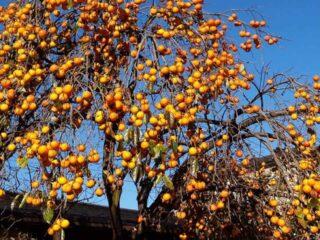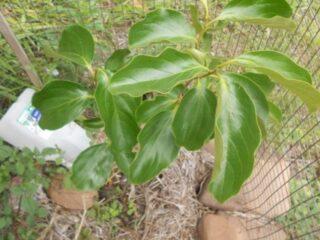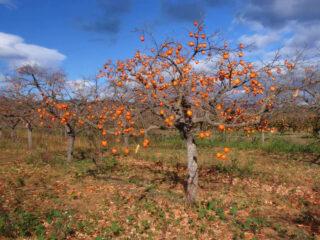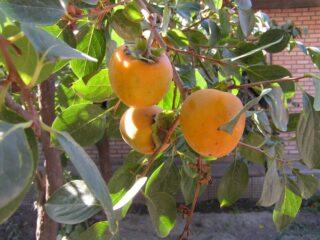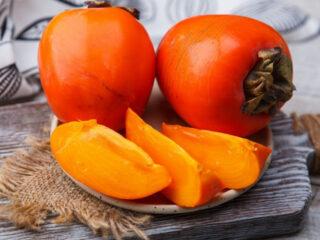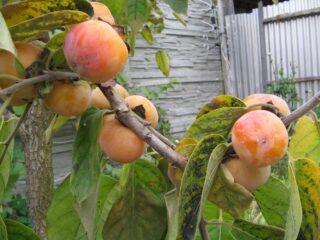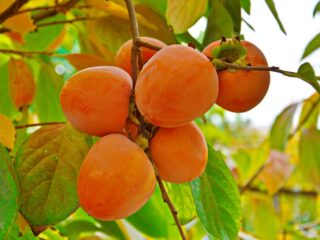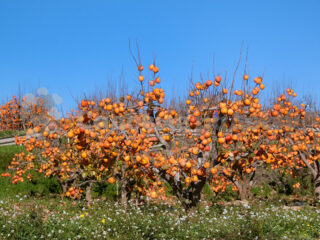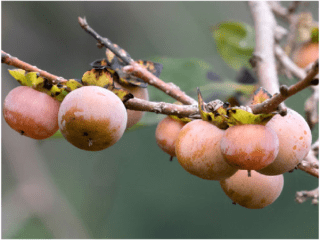Content
Among the many varieties, large-fruited Virginia persimmon stands out for its characteristics, which allow it to be grown not only in subtropical conditions, but also in more northern regions. With proper planting and proper care of trees, even in the Moscow region you can get a rich harvest of sweet amber fruits.
Description of Virginia persimmon
Virginia persimmon (Diospyros virginiana) belongs to the Ebony family. The natural habitat of the species is the Mediterranean countries and North America.
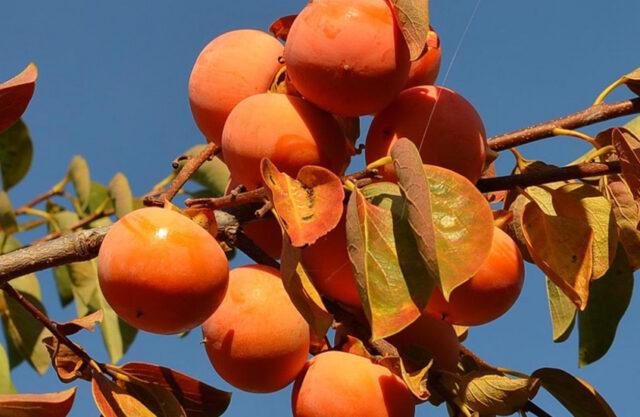
Life expectancy of Virginia persimmon is 120 years
The average height of a deciduous tree is 8 m. The bark of the trunk and branches has a gray or slightly brownish tint. Among the plants there are both monoecious and dioecious specimens. The leaf blades of Virginia persimmon are bright green, leathery, slightly heart-shaped, with a sharp tip. Their length is 15 cm.Male flowers are collected in axils in groups of three, female flowers are arranged singly. Pollination is carried out by insects or the wind. The fruits are round, up to 6 cm in diameter, weighing 50-70 g. The pulp of the berries is juicy, soft, sweet, aromatic, has the consistency of marmalade and a deep yellow color. The number of seeds may differ from one fruit to another or may be completely absent. The skin is thin, brownish, covered with a whitish waxy coating. The root system is powerful and taprooted.
Characteristics of Virginia persimmon
The variety belongs to the mid-early variety. Flowering begins in early June, which helps protect the ovaries from return frosts. The first fruits ripen at the end of September. At the age of four years, the trees begin to bear fruit. The average yield of Virginia persimmon with a height of 3 m and a crown diameter of 2.5 m, even in central Russia, is up to 50 kg per tree.
The winter hardiness of the variety is high - seedlings and mature trees can withstand frosts down to -37 ⁰C, the root system survives when the soil freezes down to -15 ⁰C. Plants easily tolerate dry periods, do not suffer from heat, and have high immunity.
Virginia persimmon is large and has excellent varietal characteristics, but for its full guaranteed growth, development and fruiting it is necessary to create conditions.
How to grow Virginia persimmon
For gardeners, growing persimmons can be a fun but painstaking process. Seeds or ready-made seedlings are used as planting material. In the first case, it will take much more time and grafting of young Virginia persimmon plants to increase yield. Ready seedlings develop faster and begin to bear fruit after two to three years.
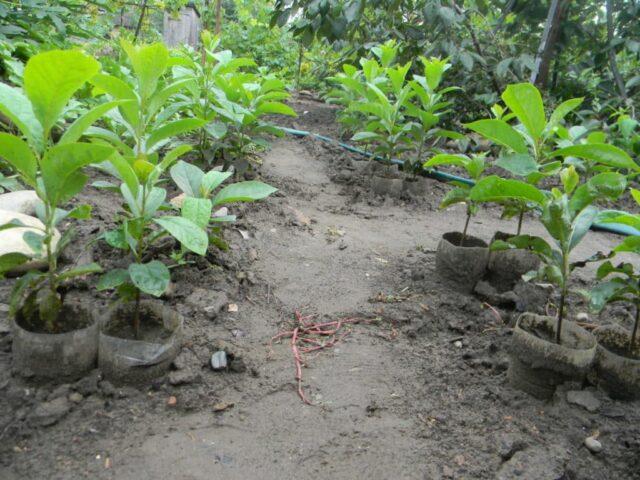
For plants with an open root system, dig holes with a width and depth of 70 cm
How to plant Virginia persimmon seedlings
Planting is carried out in the spring, when the soil has warmed up, or in the fall, before the onset of frost. Plants are purchased from professional nurseries, selecting healthy ones with a developed crown and dormant buds. The best option is a closed root system.
For a young tree, choose a place on the south side of buildings, so that in cold weather it is protected from northern winds and drafts. Loamy or sandy loam soil enriched with organic matter and nutrients is suitable for Virginia persimmon. Swampiness and groundwater levels higher than one meter are unacceptable, since most of the roots are located at a depth of up to 0.5 m.
To plant a Virginia persimmon seedling, proceed according to plan:
- Dig a hole the volume of which is two to three times the size of the container.
- Broken bricks and expanded clay are placed at the bottom to create a drainage layer.
- A soil mixture is poured on top, consisting of a third of excavated soil and two-thirds of fertile forest litter from a pine forest.
- Soak the container with Virginia persimmon in water.
- Carefully remove the root system along with a lump of earth and place it in the center of the planting hole.
- Fill the voids with soil and compact it lightly.
- Water and mulch the tree trunk circle with grass and sawdust.
- Install the support and tie it up.
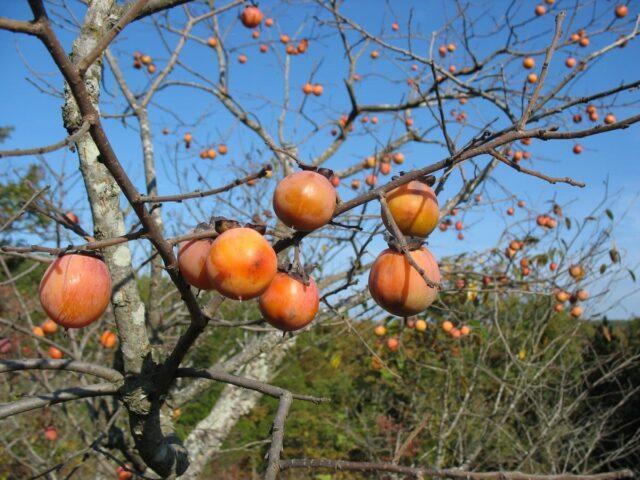
Soil with a neutral reaction (6-7.5 pH) is suitable for persimmons.
Growing Virginia persimmon from seeds
To grow a seedling, take ripe fruits, remove the seeds from them and wash them thoroughly, freeing them from the pulp.Place them in a container filled with damp sand or moss and place them on the bottom shelf of the refrigerator for two months for stratification, which allows you to increase germination to 80%. It is worth preparing in advance boxes with a soil mixture consisting of peat and sand, taken in a ratio of 1:2. In February, seeds are planted to a depth of 2 cm and covered with film, periodically moistening the soil. The first shoots of Virginia persimmon appear after two to three weeks. During this period, the shelter is removed, the seedlings are transferred to a well-lit place and additional lighting is created for them. A week later, they dive into separate pots or remove excess plants. At home, a Virginia persimmon seedling develops quickly and fills the entire volume of the container with its roots. It needs to be transplanted into a larger container. As the seedling develops, the side branches are pinched to later obtain a spherical crown. Planting in open ground is carried out in May or June, providing the plants with slight shading from the bright sun.
A guaranteed harvest of Virginia persimmon can only be obtained from grafted plants. The graft is taken from healthy varietal trees in a nursery or from familiar gardeners. If grafted at the age of one year, the first harvest will be obtained five years later.
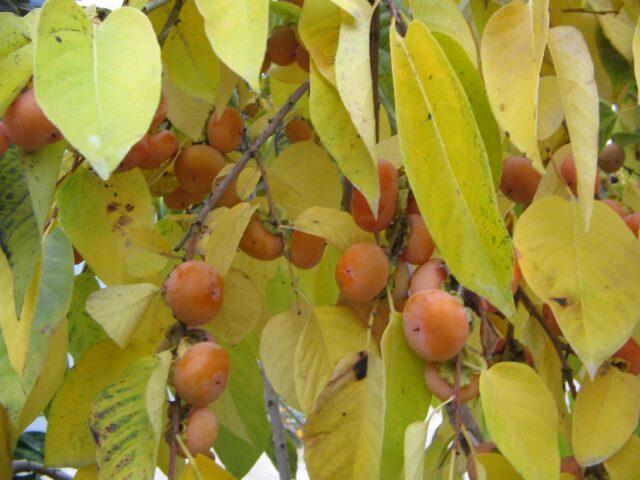
Young plants are insulated for the winter until the tree reaches a height of 2 m
Features of growing Virginia persimmon in the Moscow region
Despite the fact that persimmon is considered to be a southern plant, the exotic fruit is also grown in the Moscow region. There are several secrets for the successful growing season of Virginia persimmon in central Russia:
- For quick rooting, purchase a seedling with a closed root system.
- Several plants, male and female, are planted in one area to ensure pollination.
- The landing site should be sunny, protected from northern winds.
- When growing in a swampy area, it is worth making high-quality drainage, draining excess water and creating an elevation.
- The soil should be neutral or slightly acidic.
- Each plant is given a sufficient feeding area - at least eight square meters.
- In the first years, seedlings are provided with shelter for the winter and a system for accumulating heat.
- In winter, the bases of the trees are covered with a large layer of snow.
Gradually, Virginia persimmon acclimatizes and overwinters in subsequent years without additional protection.
Caring for Virginia persimmon
Even novice gardeners can successfully grow fruit trees if they are properly cared for. Key activities include moisturizing, fertilizing, pruning and preparing for winter.
Watering and fertilizing
Young seedlings of Virginia persimmon are watered twice a month, adult plants - once. Weather conditions, precipitation or lack thereof, should be taken into account.
At the time of planting Virginia persimmon seedlings, you should not apply nitrogen fertilizers to the hole, so as not to provoke rapid, uneven growth of shoots that will not be able to ripen before the onset of winter. Trees need adequate fertilizing from the moment they begin to bear fruit.
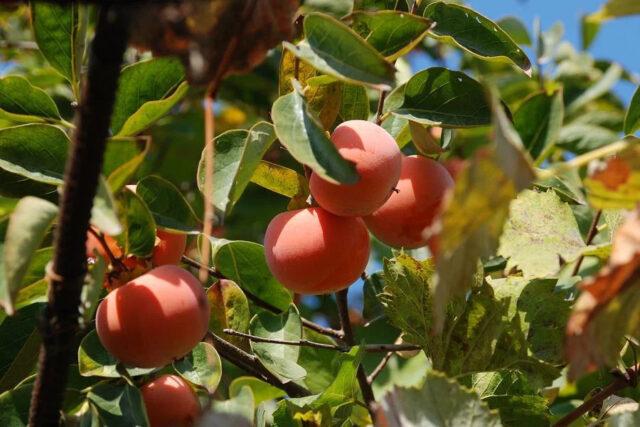
To accelerate the ripening of growth, it is permissible to apply potassium fertilizers at the end of summer
Pruning, preparing for winter
During the period of formation of skeletal branches, it is necessary to cut out weak-growing, crooked or dry shoots of Virginia persimmon. Remove branches that rub against each other and grow inside the crown.In early August, the growth point of persimmons whose wood has not yet ripened should be pinched.
Young seedlings require shelter before the onset of frost. Spandbond, agrofibre, cardboard, corn stalks and spruce branches are used to protect the trunks from drying winds, rodents, frost and sunburn.
Vaccination, protection against diseases and pests
The optimal time for vaccination is from mid-April to the end of May. Use the method most suitable for specific conditions - the method of improved copulation or splitting.
One of the advantages of Virginia persimmon is the absence of natural enemies and diseases inherent in the culture in its homeland, America. Trees must be inspected periodically to prevent the development of pathologies due to adverse weather conditions.
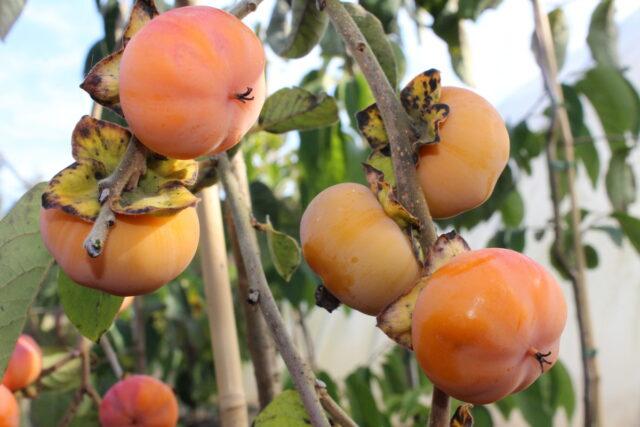
Weak shoots most often dry out and fall off on their own in the fall.
Harvesting and storage
The fruits of Virginia persimmon enter the phase of technical ripeness in the second ten days of September. During this period, they are removed and stored in a cool place. In room conditions they ripen perfectly, becoming sweet and juicy. Part of the harvest can be left on the branches; after frost, the berries lose their astringency and acquire a pleasant taste.
The fruits are used raw, dried, and added to baked goods. The pulp is suitable for making jams, preserves and marmalade. A drink reminiscent of coffee is prepared from persimmon seeds.
Conclusion
For those who love exotic plants, Virginia persimmon is a real gift. It is not difficult to grow it in the conditions of the Moscow region - it is unpretentious, grows quickly and, with proper care, produces its first harvest in a few years. Beautiful fruits at the end of autumn are an excellent motive to plant several seedlings of fruit trees.
Reviews of Virginia persimmon
